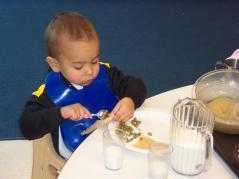New study shows it works in children, could work for adults too
One in four preschool children is overweight or obese. In a country where child and adult obesity is an epidimic, teaching children at a young age to listen to hunger cues is critical to our future. But many adults struggle with hunger cues as well, many with years of dieting behind them to wreak havoc on their natural abilities.
The new University of Illinois study of feeding practices of two- to five-year-old children in 118 child-care centers shows that when children and child-care providers sit around a table together at mealtime, passing bowls and serving themselves, children learn to recognize when they are full better than they do when food is pre-plated for them.
“When foods are pre-plated, children never develop the ability to read their body’s hunger cues. They don’t learn to say, okay, this is an appropriate portion size for me,” says Brent McBride, lead author of the study and director of the U of I Child Development Laboratory.
New national guidelines recommend that childcare providers eat with children, and ask teachers not to pressure children to take one or two more bites or finish a serving before another food or activity is offered.
“Instead of asking Are you done? teachers should ask children, Are you full? Or they should say, If you’re hungry, you can have some more,” explains Dipti A. Dev, a researcher who is developing a packet of best feeding practices to share with providers. “Asking the right questions can help children listen to their hunger and satiety signals,” she says.
“If a child doesn’t eat at one meal, he’ll compensate for it over a 24-hour period. Making kids eat when they’re not hungry is probably the worst thing you can do. It teaches them not to pay attention to their body’s signals,” Dev says.
There are several common notions that hinder family-style serving in childcare centers. “Teachers who don’t do family-style meals have all these reasons that they don’t: there’s too much waste, it’s messy, young kids don’t have the developmental skills—the fine motor control—to do that,” McBride says.
“When you first do easel painting with a two-year-old, it’s really messy because they don’t have fine motor control, but you still do it even though it’s messy. The same thing is true for family-style meal service. It may be messy at first until they develop the appropriate skills and learn to pour the right way or hold the cup as they’re pouring. It’s a developmental progression.”
“Academy of Nutrition and Dietetics Benchmarks for Nutrition in Child Care 2011: Are Child-Care Providers across Contexts Meeting Recommendations?” was published in the October 2013 issue of the Journal of the Academy of Nutrition and Dietetics. Co-authors are McBride; Dipti A. Dev, and the U of I’s STRONG (Synergistic Theory and Research on Obesity and Nutrition Group) Kids research team. The research was funded by the U.S. Department of Health and Human Services and the Illinois Trans-Disciplinary Obesity Prevention Program Seed Grant Program.

